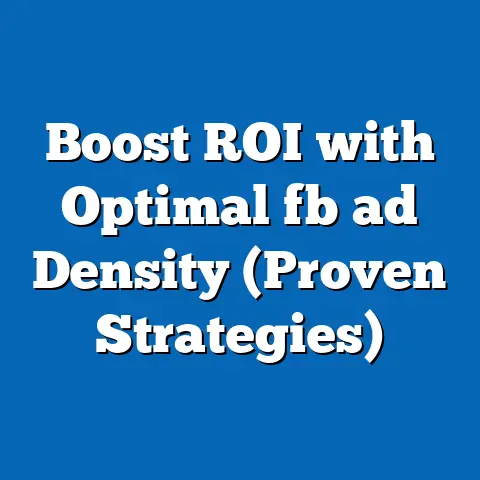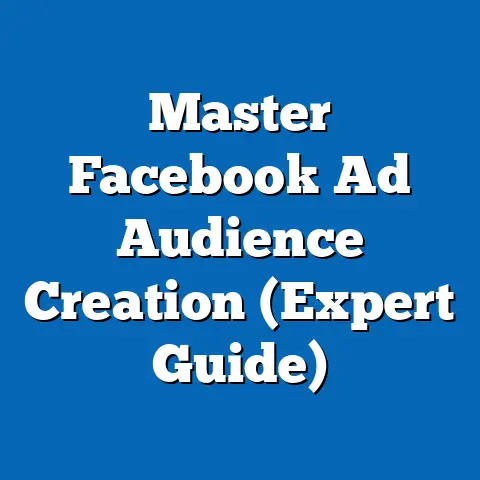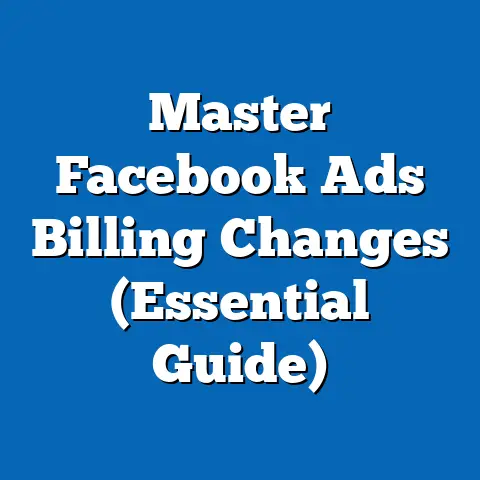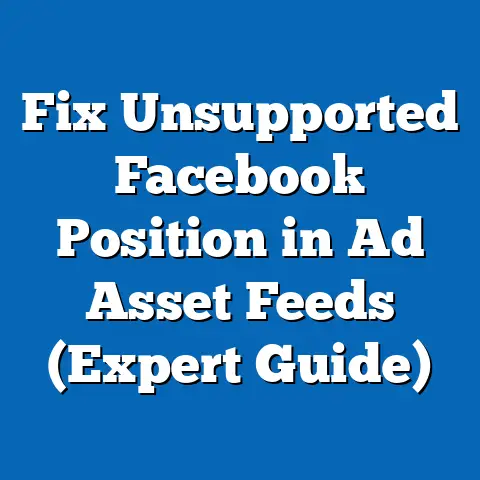Fixing Ad Block Plus Issues on Facebook (Expert Strategies)
Have you ever wondered how businesses can effectively reach their audience on Facebook, even when faced with the challenges of ad blockers like Ad Block Plus? I know I have. In my years of experience in digital marketing, I’ve seen firsthand how frustrating ad blockers can be, especially when you’ve poured time and resources into crafting the perfect Facebook ad campaign. It’s like setting sail on a beautiful day only to find yourself becalmed in the doldrums.
Ad blockers, like Ad Block Plus, have become increasingly prevalent in recent years. They’re designed to enhance the user experience by eliminating intrusive or annoying advertisements. While this is great for users, it presents a significant hurdle for marketers and businesses who rely on Facebook advertising to reach their target audience.
Understanding Ad Block Plus and Its Impact on Facebook Ads
Let’s start with the basics. What exactly is Ad Block Plus, and how does it work? Ad Block Plus (ABP) is a browser extension and application designed to block advertisements from appearing on websites and within apps. It works by using filter lists that identify and block elements on a webpage that are considered advertisements. These filter lists are constantly updated and maintained by a community of users and developers.
Think of it like a sophisticated bouncer at a club, only allowing in the content that meets its criteria (i.e., non-advertising content). It analyzes the code of a webpage and blocks elements that match the defined criteria for ads, such as specific URLs, image sizes, or scripting patterns.
The popularity of ad blockers has skyrocketed in recent years. According to Statista, as of 2023, over 763 million devices worldwide use ad blockers. While the exact percentage varies by region, a significant portion of Facebook users also employ ad blockers. This presents a major challenge for advertisers who rely on Facebook to reach their target audience.
The implications of ad blockers on advertisers are far-reaching. The most obvious impact is a loss of reach. When users block ads, your ads are simply not shown to them, reducing the potential audience size for your campaigns. This, in turn, leads to a decrease in engagement metrics such as clicks, likes, shares, and comments. Ultimately, this can result in a significant drop in revenue for businesses that depend on Facebook advertising to drive sales and conversions.
Beyond the immediate financial impact, ad blockers also affect brand awareness and customer acquisition efforts. If potential customers aren’t seeing your ads, they’re less likely to become aware of your brand or consider your products or services. This can have a long-term negative impact on your business’s growth and sustainability.
But why are users so eager to install ad blockers in the first place? Understanding the psychological factors driving this behavior is crucial for marketers. Here are a few key motivations:
- Intrusiveness: Many users find traditional banner ads and pop-up ads to be disruptive and annoying. They interrupt their browsing experience and detract from the content they’re trying to consume.
- Privacy Concerns: Some users are concerned about the tracking and data collection practices associated with online advertising. They fear that their browsing activity is being monitored and used to target them with personalized ads.
- Security Risks: Malvertising, or malicious advertising, is a real threat. Users may install ad blockers to protect themselves from potentially harmful ads that could expose them to malware or phishing scams.
- Page Load Times: Ads can slow down page load times, especially on mobile devices. Ad blockers can improve browsing speed by preventing ads from loading.
Understanding these motivations allows marketers to develop more user-friendly and respectful advertising strategies. By addressing the underlying concerns that drive users to install ad blockers, you can increase the likelihood that your ads will be seen and engaged with, even by those who use ad blockers.
Key Takeaway: Ad Block Plus and other ad blockers are a significant challenge for Facebook advertisers, leading to loss of reach, engagement, and revenue. Understanding the motivations behind ad blocker usage is crucial for developing effective mitigation strategies.
Recognizing the Symptoms of Ad Block Plus Issues on Facebook
How do you know if Ad Block Plus is impacting your Facebook ad performance? It’s not always obvious, but there are several key symptoms to watch out for. Identifying these signs early on can help you take proactive steps to mitigate the effects of ad blockers and optimize your campaigns.
The most obvious indicator is a sudden and unexplained drop in key performance metrics. Keep a close eye on the following:
- Impressions: A significant decrease in the number of times your ads are shown to users.
- Reach: A reduction in the number of unique users who see your ads.
- Clicks: Fewer clicks on your ads, indicating that fewer users are engaging with your content.
- Click-Through Rate (CTR): A lower CTR, which is the percentage of users who click on your ad after seeing it.
- Conversions: A decline in the number of desired actions taken by users, such as purchases, sign-ups, or leads.
- Website Traffic: A decrease in traffic to your website from Facebook ads.
It’s important to note that these metrics can fluctuate for various reasons, such as changes in your targeting, ad creative, or bidding strategy. However, if you notice a sudden and persistent drop in performance across multiple campaigns, it’s a strong indication that ad blockers may be playing a role.
To get a clearer picture, compare your current ad performance to historical data. Look for trends and patterns that might suggest an impact from ad blockers. For example, you might notice that your impressions and reach are significantly lower compared to the same period last year, even though your budget and targeting are similar.
I remember one instance where a client of mine, a local restaurant, experienced a sudden drop in website traffic from their Facebook ads. Initially, we suspected a technical issue with their website or a problem with their ad targeting. However, after digging deeper into the data, we discovered that their impressions and reach had also declined sharply, particularly among users in certain demographic groups. This led us to suspect that ad blockers were the culprit.
To confirm our suspicions, we conducted a simple test. We created a new ad campaign with a slightly different ad creative and targeting, and we monitored its performance closely. We also used a third-party tool to estimate the percentage of users in our target audience who were using ad blockers. The results confirmed our suspicions: the new campaign performed significantly better, and the estimated ad blocker usage rate was high among the users who weren’t seeing our ads.
Differentiating between organic drops in performance and those caused by ad blockers can be tricky. Here are a few tips:
- Analyze Audience Demographics: Ad blocker usage rates vary by demographic group. If you see a disproportionate drop in performance among certain age groups or geographic locations, it could be a sign of ad blocker influence.
- Monitor Website Analytics: Check your website analytics to see if traffic from Facebook ads is declining while organic traffic remains stable. This could indicate that ad blockers are preventing users from clicking on your ads.
- Use Ad Blocker Detection Tools: Several tools can help you estimate the percentage of users who are using ad blockers on your website or within your Facebook audience.
- Compare Performance Across Platforms: If you’re running ads on other platforms like Google Ads or Instagram, compare their performance to your Facebook ads. If your Facebook ads are underperforming relative to other platforms, it could be a sign of ad blocker issues.
By carefully monitoring your ad performance and analyzing the data, you can effectively identify the symptoms of Ad Block Plus issues on Facebook and take appropriate action.
Key Takeaway: Watch for sudden drops in impressions, reach, clicks, CTR, conversions, and website traffic. Compare current performance to historical data and analyze audience demographics to identify potential ad blocker issues.
Expert Strategies to Mitigate Ad Block Plus Issues
Now that you understand the problem and how to identify it, let’s dive into the solutions. Here are several expert strategies you can use to mitigate the impact of Ad Block Plus on your Facebook ad campaigns:
3.1. Crafting Non-Intrusive Ad Content
The most effective way to combat ad blockers is to create ads that users don’t want to block in the first place. This means focusing on creating engaging, valuable content that resonates with your target audience. Avoid overly promotional or intrusive ads that interrupt the user experience.
Here are some tips for designing non-intrusive ads:
- Focus on Value: Provide useful information, solve a problem, or entertain your audience. Think about what your target audience wants and needs, and create ads that address those desires.
- Blend In: Design your ads to look and feel like organic content. Use high-quality images and videos that are visually appealing and relevant to your audience.
- Tell a Story: Use storytelling to connect with your audience on an emotional level. Share personal experiences, customer testimonials, or case studies that showcase the benefits of your product or service.
- Be Transparent: Clearly identify your ads as sponsored content, but avoid using overly aggressive or salesy language.
- Respect User Preferences: Pay attention to user feedback and adjust your ad creative accordingly. If users are consistently blocking your ads, it’s a sign that you need to rethink your approach.
I’ve found that ads that provide genuine value and blend seamlessly into the user’s feed are far more likely to be seen and engaged with, even by those who use ad blockers. Think about creating content that users would actually want to share with their friends and family.
3.2. Leveraging Alternative Advertising Formats
Facebook offers a variety of ad formats beyond the traditional news feed ad. Exploring these alternative formats can help you bypass ad blockers and reach a wider audience.
Here are a few alternative ad formats to consider:
- Stories Ads: Stories ads appear between users’ organic stories. They’re typically full-screen and immersive, offering a unique opportunity to capture attention.
- Video Ads: Video ads are highly engaging and can be used to tell a compelling story or showcase your product or service in action.
- Carousel Ads: Carousel ads allow you to display multiple images or videos in a single ad unit. This is a great way to showcase different products or features.
- Instant Experience Ads: Instant Experience ads (formerly known as Canvas ads) are full-screen, interactive ads that load instantly when a user clicks on them. They’re designed to provide a rich and engaging experience.
- Collection Ads: Collection ads are designed for e-commerce businesses. They allow you to showcase a catalog of products in a visually appealing format.
Sponsored content and influencer partnerships are another effective way to bypass ad blockers. By partnering with influencers who have a loyal following, you can reach a wider audience and build trust with potential customers. Influencers can create authentic content that promotes your brand in a natural and engaging way.
I’ve seen great success with influencer marketing. It’s all about finding the right influencers who align with your brand values and target audience. When done right, influencer marketing can be a powerful way to reach new customers and build brand awareness.
3.3. Utilizing Retargeting and Custom Audiences
Retargeting is a powerful technique that allows you to reach users who have already interacted with your brand. This is particularly effective for mitigating the impact of ad blockers because these users are already familiar with your brand and are more likely to be receptive to your ads.
You can create custom audiences based on various criteria, such as:
- Website Visitors: Target users who have visited your website.
- Email Lists: Upload your email list to Facebook and target users who are on your list.
- App Users: Target users who have downloaded and used your app.
- Engagement on Facebook: Target users who have liked your page, watched your videos, or interacted with your posts.
By targeting these custom audiences, you can increase the relevance of your ads and improve your chances of reaching users who are more likely to convert.
I always recommend starting with retargeting campaigns. These campaigns are typically more cost-effective and have a higher conversion rate than prospecting campaigns because you’re targeting users who are already familiar with your brand.
3.4. Building a Strong Organic Presence
While paid advertising is essential, building a strong organic presence on Facebook can help offset the impact of ad blockers. By creating valuable content and engaging with your audience, you can build a loyal community that will continue to see your posts even if they’re using ad blockers.
Here are some tips for building a strong organic presence:
- Post Regularly: Maintain a consistent posting schedule to keep your audience engaged.
- Create Valuable Content: Share content that is informative, entertaining, or inspiring.
- Engage with Your Audience: Respond to comments and messages promptly and participate in relevant conversations.
- Run Contests and Giveaways: Contests and giveaways are a great way to generate excitement and engagement.
- Use Facebook Live: Facebook Live allows you to connect with your audience in real-time.
Building a strong organic presence takes time and effort, but it’s a worthwhile investment. A loyal community can provide valuable feedback, advocate for your brand, and help you reach new customers.
3.5. Exploring Alternative Platforms and Channels
Don’t put all your eggs in one basket. Diversifying your ad spend across other platforms and channels can reduce your reliance on Facebook and mitigate the impact of ad blockers.
Consider exploring the following platforms:
- Instagram: Instagram is a highly visual platform that’s popular among younger demographics.
- Google Ads: Google Ads allows you to reach users who are actively searching for your products or services.
- TikTok: TikTok is a fast-growing platform that’s popular among Gen Z.
- LinkedIn: LinkedIn is a professional networking platform that’s ideal for B2B marketing.
A multi-channel marketing strategy allows you to reach a wider audience and diversify your risk. By spreading your ad spend across multiple platforms, you can reduce the impact of ad blockers on any single channel.
Key Takeaway: Mitigate ad blocker issues by crafting non-intrusive ad content, leveraging alternative ad formats, utilizing retargeting and custom audiences, building a strong organic presence, and exploring alternative platforms and channels.
Tools and Technologies to Aid in Ad Performance
In the fight against ad blockers, having the right tools and technologies at your disposal is crucial. These tools can help you analyze ad performance, identify issues caused by ad blockers, and optimize your campaigns for maximum impact.
Here are some essential tools to consider:
- Facebook Analytics: Facebook Analytics provides detailed insights into your ad performance, including impressions, reach, clicks, conversions, and cost per result. Use this tool to monitor your key metrics and identify any sudden drops in performance.
- Google Analytics: Google Analytics provides detailed data on your website traffic, including traffic from Facebook ads. Use this tool to track conversions and measure the ROI of your Facebook ad campaigns.
- Ad Blocker Detection Tools: Several tools can help you estimate the percentage of users who are using ad blockers on your website or within your Facebook audience. These tools can provide valuable insights into the impact of ad blockers on your ad performance. Examples include Blockmetry and Admiral.
- A/B Testing Tools: A/B testing tools allow you to test different ad creative, targeting options, and bidding strategies to see what works best. This is essential for optimizing your campaigns and mitigating the impact of ad blockers. Facebook itself offers A/B testing capabilities within Ads Manager.
- Heatmap Tools: Heatmap tools like Hotjar or Crazy Egg can show you how users are interacting with your website. This can help you identify areas where users are dropping off or not engaging with your content.
Analytics plays a crucial role in understanding user behavior and optimizing ad delivery. By analyzing your ad performance data, you can identify patterns and trends that might suggest an impact from ad blockers. For example, you might notice that your impressions are significantly lower among users in certain geographic locations or age groups.
A/B testing is also essential for determining the most effective ad strategies. By testing different ad creative, targeting options, and bidding strategies, you can identify what works best for your target audience and optimize your campaigns accordingly.
I’ve always been a big advocate of data-driven decision-making. By using these tools and technologies to analyze your ad performance and understand user behavior, you can make informed decisions that will help you mitigate the impact of ad blockers and maximize your advertising ROI.
Key Takeaway: Utilize Facebook Analytics, Google Analytics, ad blocker detection tools, A/B testing tools, and heatmap tools to analyze ad performance, identify issues caused by ad blockers, and optimize your campaigns.
Looking Ahead: The Future of Advertising in a World with Ad Blockers
The landscape of digital advertising is constantly evolving, and ad blockers are likely to remain a significant challenge for marketers in the years to come. However, there are several emerging trends that may influence how marketers approach ad blockers in the future.
One potential solution is the development of more user-friendly and less intrusive ad formats. Technology companies are exploring new ways to deliver ads that are less disruptive and more relevant to users’ interests. This could include native advertising, which blends seamlessly into the surrounding content, or personalized ads that are tailored to individual user preferences.
Another potential solution is the development of new technologies that can bypass ad blockers. Some companies are working on algorithms that can identify and circumvent ad blockers, allowing ads to be shown to users even if they have an ad blocker installed. However, this approach is controversial and could lead to an arms race between advertisers and ad blocker developers.
Ultimately, the future of advertising in a world with ad blockers will depend on the evolution of user behavior regarding ad consumption. As users become more accustomed to seeing ads, they may become less likely to install ad blockers. However, if ads continue to be intrusive and irrelevant, users will likely continue to seek out ways to block them.
Businesses can adapt by focusing on creating valuable content that users actually want to see. This means shifting away from traditional advertising tactics and embracing content marketing, influencer marketing, and other forms of organic reach. By building a strong relationship with their audience and providing them with valuable information, businesses can earn their trust and loyalty, even if they’re using ad blockers.
I believe that the future of advertising is about building relationships with your audience and providing them with value. It’s about creating content that they actually want to see and engage with, rather than bombarding them with intrusive ads. By focusing on building relationships and providing value, businesses can overcome the challenges posed by ad blockers and thrive in the evolving digital landscape.
Key Takeaway: The future of advertising in a world with ad blockers will depend on the development of more user-friendly ad formats, new technologies that can bypass ad blockers, and the evolution of user behavior regarding ad consumption. Businesses can adapt by focusing on creating valuable content and building strong relationships with their audience.
Conclusion
Ad Block Plus and other ad blockers present a real and ongoing challenge for Facebook advertisers. However, as I’ve outlined in this article, marketers have a variety of tools and strategies at their disposal to effectively navigate these obstacles.
By crafting non-intrusive ad content, leveraging alternative ad formats, utilizing retargeting and custom audiences, building a strong organic presence, and exploring alternative platforms and channels, you can mitigate the impact of ad blockers and maximize your advertising ROI.
Remember, the key is to be proactive rather than reactive in your marketing strategies. Don’t wait until you see a drop in performance to take action. Start implementing these strategies today to protect your advertising efforts from the effects of ad blockers.
I encourage you to take the following actionable steps:
- Review your current ad campaigns: Identify any ads that might be considered intrusive or overly promotional.
- Experiment with alternative ad formats: Try using Stories ads, video ads, or carousel ads to see if they perform better than traditional news feed ads.
- Create custom audiences: Target users who have already interacted with your brand.
- Develop a content marketing strategy: Create valuable content that your audience will want to see and share.
- Explore alternative platforms: Consider diversifying your ad spend across other platforms like Instagram, Google Ads, or TikTok.
By taking these steps, you can enhance your Facebook ad campaigns in light of ad blocker usage and achieve your marketing goals. Don’t let ad blockers hold you back. Embrace these strategies and take control of your advertising destiny!






